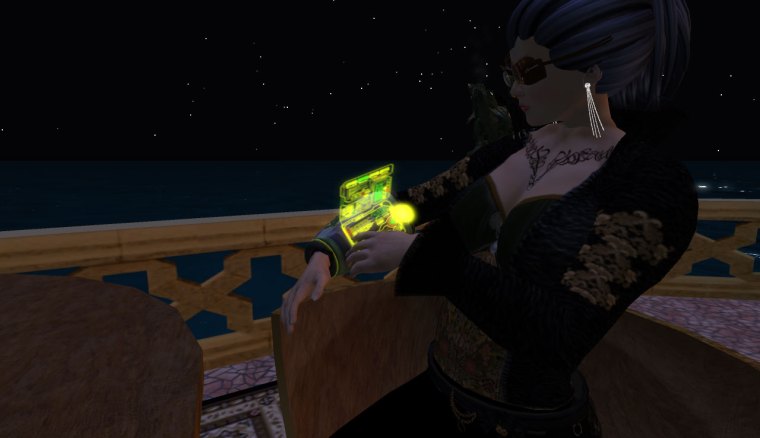
‘Rome is full of energy’ by elros Tuominen
Communication technologies have been created to help us overcome the physical separation of distance. The measure of the success of these technologies revolves around how much we can create a sense of immediacy, and closeness to each other (despite the miles between us). If we can understand just what makes up social presence then we can deepen our understanding of ourselves, our minds and each other. I define social presence as ‘how much we experience others as breathing, thoughtful, emotional beings with whom we might share some degree of empathy’. (There are far more intellectual definitions of Social Presence Theory, I have simply created my own definition to reflect those aspects of SPT that interest me personally as a virtual world traveller.)

Detail of light sculpture by elros Tuominen
The illusion of compressed distance does not necessarily equate with a comfortable sensation. I am thinking of a friend who described using voice in Second Life to chat to the avatar of someone who lived in another country. She said she felt as though the person behind the avatar was in the same room, and it was scary because she had no idea who the other person was in reality.
Perhaps, today’s sophisticated technologies sometimes feel too real and immediate? Heightened reality is not necessarily what we want in our communications nor does it automatically provide strong social presence. Seeing and hearing each other does not immediately produce mutual understanding, as we all know from face to face situations! It may even be the case that we desire a little distance from each other’s physical, and social presence, to experience each other’s essential self or ‘essence’? That is, we want to get past the distractions of real world, skin deep, appearances to reach each other’s (more genuine?) inner self. As it is, we can determine our appearance as avatars in virtual worlds, then adjust them to represent selected aspects of ourselves. We seek different levels of reality for different situations, and avatars perhaps become an emotional expression of self? Maybe this is the reason why people have more than one avatar? Each avatar reflects different dimensions of our personality and can be selected for different situations? (A rubric cube of selves?)

Ivory Tower Library of Primitives (textures display detail)
When business people are wheeling and dealing they tend to trust conservative clothing and want to glimpse the whites of each others eyes. (As though that conveys a more honest interaction?) But what’s this? Businesses are making use of Second Life as a communication platform to use for virtual meetings. How do they dress their avatars I wonder? (Do they have the added pressure of being ‘known’ in the real world and so will they be judged by their avatar’s appearance in the virtual world?)
There was an interesting discussion recently on SLED’s listserv about how avatars should dress to be taken seriously by those who are ignorant of virtual worlds. One idea put forward was that (when introducing Second Life to *Sluggles) people could dress their avatars in something akin to interview suits for such occasions! Others felt this was not the solution, as avatars are a form of self expression and people should stay true to themselves! This conversation thread was the result of the funny (but could have been much funnier) sketch about Second Life users on the Jon Stewart Daily Show.
Appearance in the virtual world is becoming more significant as the numbers of avatars increase. (And don’t forget the ‘augmentalist v immersonalist’ debate!) Our avatars are unique communication devices in and of themselves. They are created by us in Second Life (and other virtual worlds) and acquire unique features turning them into digitalized, yet strangely emotional, fingerprints of ourselves as we sit at our keyboards.

Neko avatar with butterfly wings and leopard skin spots in the grid!
At the same time as having their appearance constructed by us, our avatars become the medium of communication once we are inside our selected virtual world. Here we are, now able to mine down through layers of communication tools to end up with these personalized ‘speakers’. (The layers: personal computer via a modem; connects to a server; that runs a program; within which we create an individualized communication tool called an avatar; who can communicate with other avatars!) We talk about getting new skins for software applications, this metaphor of ‘skins’ comes full circle when we acquire virtual skins for avatars. The avatar becomes a personalized software device or communication application. Add into this picture the knowledge that, at this very moment, developers are creating ‘doors’ in virtual worlds which will enable us to walk from one virtual world into another using our personal avatars!
Maybe the next step will be to create avatar building software that has an embedded ‘degrees of reality’ dial in the preferences section? Then, according to our personal comfort levels, and different virtual environmental situations, we can adjust our avatar for any and every occasion in the metaverse!
Sluggles: Cyberloom’s description that borrows from J.K. Rowling’s ‘muggles’ to describe people who are ignorant or skeptical of how Second Life can be used as a communication platform.














